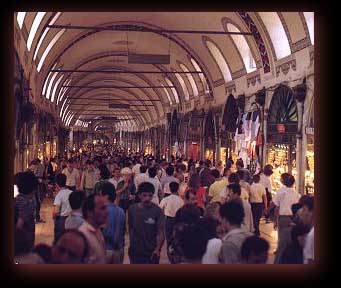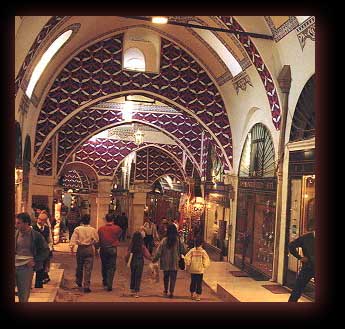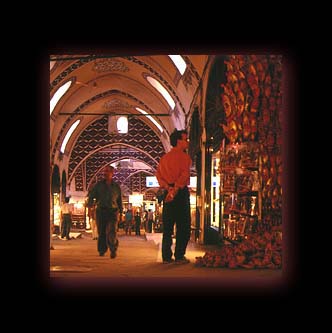

 |
|||||||||
|
Grand Bazaar The foundations of one of the most outstanding covered markets of Istanbul, the Grand Bazaar, which stretch from Beyazit to Nuruosmaniye, were laid out immediately after the conquest of Istanbul. The Conqueror first laid the foundations of the old bedesten (market), and these were followed by those of the Sandal bedesten. The bazaar grew from shops and hans, lining the streets, which had the space between covered over for more convenient shopping. The resulting arcades were covered with roofs and arches, and were illuminated by clerestorey windows. Each street became the center of one particular trade, such as the street of the slipper - makers, furniture - makers and quilt - makers. |
|||||||||
 |
|||||||||
| The bazaar comprised 4400 shops. 40 hans on over 50 streets, 2200 rooms to the hans, together with business premises, mosques and 19 fountains and hamams, making up what was effectively a city within itself. The covered bazaar itself consisted of the Bedesten at the center, which was entered by four main gates, the Gates of the Sahaflar (Goldsmiths), Takkeciler (Cap - Makers). Zenneciler (Fripperies Womans Garments) and Kuyumcular (Jewelers). The main streets were named the streets of the Tent - Makers (Çadircilar), Quilt - Makers (Yorgancilar), Fez - Makers (Fesciler), Fur Hat - Makers (Kalpakcilar), Pouch - Makers (Keseciler), Cap - Makers (Takkeciler), and Nuruosmaniye. | |||||||||
 |
|||||||||
| These streets were attached to a maze of roads and alleys. The most important of the streets which numbered up to fifty were the streets of the Clog - Makers (Kavaflar), Printed - Clothier (Basmacilar), Sandal Bedesten and Aga Sokak. The Bazaar underwent a great threat during the fire of 1546 and was later seriously damaged and restored after the fires of 1660, 1695, 1701 and 1750. During the earthquakes of 1766, 1791, 1826 and1894 it was badly damaged, and the Hans of the Market were completely destroyed and closed down. The street of the Kalpakci between Beyazit and Nuruosmaniye was closed off by gates at each end over which the Tughra (Coat of arms) of Abdülhamid II was mounted. The Covered Bazaar underwent fires during 1943 and 1954 which destroyed much that was authentic. However it still retains its attraction as the center for Turkish jewelry, carpets embroidery and such like handicrafts. The market, which began to grow over the foundations of the old Bedesten and later the Sandal Bedesten gradually grew to its present state. The first nucleus of the market, the old bedesten was surrounded by walls 1.5 m thick, covered by 15 cupolas and itself covered an area 45 by 29.5 m, a total of 1336 sq. meters. The four gates of this market opened onto the streets of Keseciler, Takkeciler, Sarraflar and Kuyumcular. | |||||||||
 |
|||||||||
